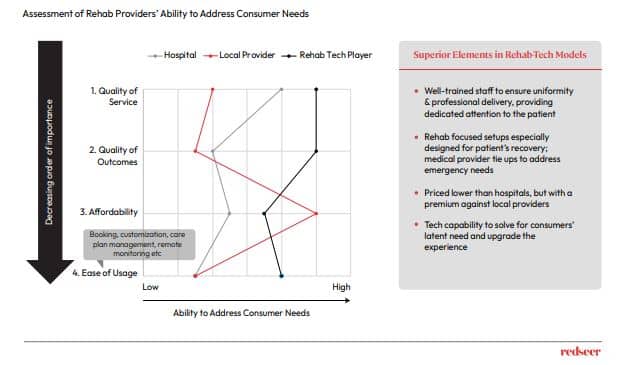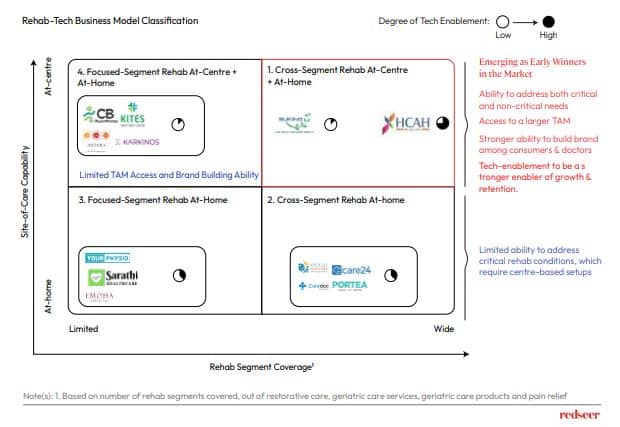India’s healthcare sector is tremendously diverse, with potential in every segment, including providers, payers, and medical technology. As one of the leading medical destinations in the post-pandemic times, India has emphasized making the healthcare sector digital and tech friendly. Along the same lines, rehabilitation technology has emerged as one of the promising sectors to ensure a person can regain, maintain, or improve everyday living abilities. Notably, this healthcare service has ascended in the post-pandemic world, pushing the growth of the rehab tech market, which is projected to accelerate in the next five years.
Want to evaluate new investment and M&A opportunities?
Here’s a deeper insight into the growing need for Rehab Tech in India.
1. Rehab is defined as the set of interventions optimizing functioning and reducing disability per WHO

As per WHO, rehab helps optimise functioning and reduce disability in individuals with health conditions. In line with the same, physical rehab (excluding mental and drug/alcohol rehab) is classified into three major segments – restorative care, geriatric care and pain relief, depending on the criticality of the health condition and the patient age group. In addition, it typically involves providing products & services such as nursing, caregiving, physiotherapy, occupational therapy and medical equipment – these can be availed at home and rehab centres.
2. ~USD 17 Bn opportunity, projected to double in the next 5 years

35-40% of the physical rehab spend in India is concentrated in the top 10 cities. The market is projected to grow at a CAGR of 15.5% in the next 5 years to reach USD 35 Billion by FY2028, primarily led by the increase in rehab adoption – lack of awareness & willingness, sparse availability and limited capabilities of rehab providers are currently restricting the usage of rehab, despite the strong need in certain health conditions.
This gap is strongly observed in the geriatric care segment, wherein a large 40%+ elderly population needs a rehab service in the form of caregiving or assisted living, but only ~6% of the population avails of such a service. While a part of lower adoption is led by limited paying capacity, another sizeable part is led by social stigmas (against medical help from individuals outside the family) and a lack of awareness of rehab needs & providers. Such factors are likely to be addressed significantly in the next 5 years, enabling rapid growth in the geriatric care segment.
3. Business economics are attractive too

In addition to being a large opportunity, physical rehab comes with attractive business economics. This is indicated by the healthy gross margins of rehab providers and impressive consumer lifetime value across the major segments. For example, in the case of restorative rehab (which is ~28% of the market), a consumer typically uses it once in a lifetime but spends USD 650-700 (~INR 50k) for a rehab treatment lasting 12 days. Further, the restorative rehab provider makes 50-55% gross margins of this spend by consumers. This is quite lucrative compared to other health sectors, such as ePharma, wherein the consumer LTV is in the range of USD 50-70, with gross margins of 25-30%.
4. Rehab-tech players are able to better address the consumer needs

The majority of rehab is currently provided by hospitals and local unorganized players – hospitals dominate the critical restorative rehab segment, and local providers lead the non-critical geriatric & pain-relief segments. However, both of them aren’t able to aptly serve consumer needs. Despite providing a standard service, consumers find rehab at hospitals to be expensive and lacking a recovery-focused environment. And, while local players are more affordable, they lack the basic quality & professionalism in service and have limited ability to address complex situations. This has created a strong need for rehab tech players, who are solving these problems with a clear focus on creating high-quality outcomes for consumers.
Consumers’ latent needs related to the ease of availing rehab (e.g. booking, customization, care plan management, remote monitoring etc.) have also become relevant in recent times. Rehab-tech players can address these needs via technology, which provides them with a further edge over traditional hospitals & local rehab providers. Moreover, the usage of the technology enables these players to accelerate their consumer acquisition and deepen engagement, translating to faster growth in business.
5. Players with wide segment & site-of-care presence and tech focus, are emerging as early winners

The rehab tech players are classified based on the extent of rehab segment coverage, at-home and at-centre rehab capabilities and the degree of tech enablement. Players with wide segment coverage have access to a larger TAM and the potential to create a stronger brand in the rehab space among both consumers and doctors. Also, having centre-based rehab capability is a strong moat, given certain key health conditions (especially in restorative care) require patients to undergo rehab at centres. Moreover, players with stronger tech enablement are better placed to thrive in the market, as they are likely to build superior consumer acquisition and retention funnels.
Further, to scale in this market, rehab-tech players need to have good control over the training & onboarding of their medical staff, as they hold the key to the quality of consumers’ experience. Moreover, winning doctors’ trust and developing a perpetual relationship with them is crucial. And it is recommended that these players target the right health conditions where they can create a meaningful difference over the traditional rehab providers (e.g. conditions that require a longer rehab or demand complex supervision).
All of this boils down to the strength of healthcare expertise that Rehab-tech players can develop.








